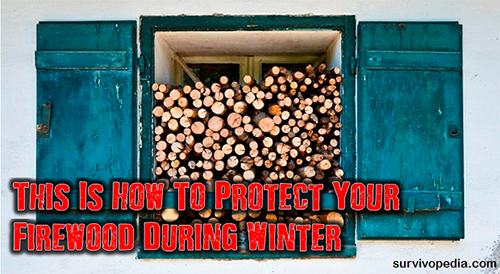To quote one of my favorite movies, “Brace yourself, winter is coming” folks. And if you’ve chosen wood for heating your homestead, you should pay extra-attention to this article.

Wood is an excellent choice for keeping your home cozy and warm during the harsh winter months and is the perfect alternative for cutting your heating costs, because it’s much less expensive than central heating that uses gas or electricity.
Especially when heating large rooms, wood works better than almost anything else. It’s a very cheap, efficient and quick heating method..
What Works and What Doesn’t
Now, that we’ve established that wood is a good alternative to electric or gas for heating, let’s see what makes for good firewood.
The difference between the good, the bad and the ugly when it comes to firewood is the moisture content and the density, because in final analysis, all trees are more or less “built” from the same stuff, chemically.
So, you should choose harder woods for your winter supply, which are denser than the softer varieties. Go for oak, ash, locust, black maple and hickory. These woods tend to burn way longer than the others and the coals they produce are hotter.
These qualities are great for the coldest months of the winter, and even for those long, chilly nights of late fall and early spring. Plus it’s efficient, as we’ll soon discuss.
You may be fooled by the abundance and cheapness of the softer woods, such as pine, but these tend to burn pretty quickly, and you’ll have to haul heavy loads day after day, maybe more often than you’d like, wasting time and effort. In the end, you’ll likely spend just as much buying the cheap stuff because you’ll burn twice as much of it.
Storing Your Winter Wood Properly
Regardless of the type of wood you’ve chosen, the biggest problem, especially during the winter, is the storage issue. It’s crucial to choose the proper storage method when it comes to your wood supply, thus protecting your investment and your hard work. You may have spent weeks cutting your firewood for the winter season ahead, but make sure that you don’t skip the final, extremely important step: stacking it.
Wood is highly susceptible to exposure to the elements, especially snow and rain. If your wood supply is stored improperly and it gets wet, that will lead to decay. Also, a pile of wood looks really cozy to various species of animals, snakes and insects looking for shelter, and I bet that’s not what you had in mind for your firewood stack, right?
Firewood that comes in direct contact with the ground is prone to insects and moisture exposure, and these accelerate the wood’s rate of decay, rendering it useless over time. By far, moisture is wood’s biggest enemy, as it also dramatically increases the chances of mold taking over your firewood supply.
All these things considered, it looks like the most challenging aspect of storage is how to keep your logs dry , isn’t it?
Having dry logs will make all the difference in the world when it comes to the efficiency of the wood stove/wood burner/chimney etc. This is a huge factor affecting the amount of heat your wood will produce. Keeping your firewood supply as dry as possible will maximize your investment and it’s beneficial for your homestead long-term.
Where Should You Start?
The first thing to contemplate is seasoning. Wood must be properly seasoned, and I mean dried, before you light your first winter fire. An insufficiently dried wood will tend to ignite harder, will burn inefficiently and will produce sub-par amounts of heat despite having a flame. It will also smoke and smolder.
How do you know your wood is seasoned good and proper? A few hints: dry wood is lighter (less moisture-less weight) and its ends are cracked. It turns deep brown, yellow or gray as it dries (wet/green wood is cream, white or light brown) and if you smash two logs together, they’ll sound hollow when they’re good and dry. Wet wood makes a dull thud.
To get the general idea about proper seasoning, softer essences of wood require six to twelve months while harder ones will need twice that (1 to 2 years).
To achieve proper seasoning, you should split the firewood before storing it into smaller sections, thus speeding up the drying process. Splitting it up increases the surface area which is exposed to the air. Alternatively, you can buy already split logs from a reputable supplier, to make sure you get high quality firewood that’s split properly.
You should allow the firewood to dry in the open air completely before storing it long term. The most important factor that contributes to open-air drying is the wind, as it speeds up the process, but never allow your logs to sit outside uncovered during a rainstorm. If your wood supply gets damp, it will take a long time to dry it out again.
Now, let’s see about storage options. Before storing your wood for the winter season, you must learn how to stack it properly.
This may take a little practice, but it’s very important to stack your firewood the right way when storing it. The general idea is to allow the air to circulate freely by leaving gaps between the logs and each layer must be stored in the opposite direction of the next, to assure the best ventilation possible. Check out the video below.
Video first seen on Cottage Life DIY
If your firewood is stacked next to a shed, a wall or some other structure, allow plenty of space between the stack and the respective wall (at least a 2 to 4 inch gap) , to allow the air to circulate freely. Failing to do that is a common mistake folks tend to make and it leads to termites popping up in your wood supply and wet logs. Oh yeah, and in your house, too, if it’s wood.
Another common mistake and one that can cause the most damage, is to cover your logs completely, thus stopping air circulation. This translates into moisture taking over, damaging the firewood and rendering it useless. If you cover your wood stack, be sure to allow proper aeration by leaving the sides uncovered.
Always remember to bring the logs inside your house a day in advance before you use them for heating purposes. Store them inside in a dry location such as your wood bin and they’ll be in perfect shape the following day. That brings us to storage options.
What About Storage Options?
Always think ahead when it comes to storing firewood. The general idea is to choose the perfect location at each step, from where you’re going to let it season, to where you’re going to store it within reach, to where you’re going to store it once you bring your firewood into the house.
Just think about it: logs are bulky and heavy, and carrying them day after day to your house is hard work, especially if you’ll require several trips for a day’s supply. So, do yourself a “solid” and store your seasoned firewood as close and as practical as possible to your heating device. You’ll thank yourself later.
Obviously, firewood must be stored outside of your home, never inside. Just think about termites and ants, along with other nastier bugs. They all love wood and you don’t want these intruders inside of your house now, do you?
Talking about outside storage, there’s an invention called a woodshed. While you can keep a small amount of wood inside the home, ready to be burned, seasoned firewood is best kept in an outside woodshed.
Video first seen on Jyienger
If that’s too much for you, a DIY log rack is the next best thing for storing wood for the winter. It’s important that you elevate it, at least 2-3 inches off the ground, to keep your firewood dry and protected from insects.
If stacking firewood outside, it would be a great idea to cover it, in order to protect your supply from the elements, but remember to avoid the mistakes we’ve already mentioned. You will find specially designed rack covers in retail stores, featuring tie downs to keep them from flying away when the wind blows. These covers also have slits or perforations in the material to keep the air flowing freely.
Obviously, you can store firewood under any solid structure, such as an awning or a garage roof, or even a basement if it’s not connected to the rest of your house as long as you follow the rules of ventilation, elevation and space that we’ve already discussed.
Always remember to put the larger logs at the bottom of the stack in level rows and make sure your pile isn’t leaning. Also, don’t build the firewood-stack too high, which will make it difficult for you or shorter family members to reach, and will also make it dangerous to be around because it may lean or even fall over somebody.
I hope the article helped and if you have ideas or comments, feel free to use the dedicated section below, we’d appreciate your feedback.
This article has been written by Chris Black for Survivopedia.
Saving our forefathers ways starts with people like you and me actually relearning these skills and putting them to use to live better lives through good times and bad. Our answers on these lost skills comes straight from the source, from old forgotten classic books written by past generations, and from first hand witness accounts from the past few hundred years. Aside from a precious few who have gone out of their way to learn basic survival skills, most of us today would be utterly hopeless if we were plopped in the middle of a forest or jungle and suddenly forced to fend for ourselves using only the resources around us. In short, our ancestors lived more simply than most people today are willing to live and that is why they survived with no grocery store, no cheap oil, no cars, no electricity, and no running water. Just like our forefathers used to do, The Lost Ways Book teaches you how you can survive in the worst-case scenario with the minimum resources available. It comes as a step-by-step guide accompanied by pictures and teaches you how to become 100% self sufficient.
 Here’s just a glimpse of what you’ll find in The Lost Ways:
Here’s just a glimpse of what you’ll find in The Lost Ways:
From Ruff Simons, an old west history expert and former deputy, you’ll learn the techniques and methods used by the wise sheriffs from the frontiers to defend an entire village despite being outnumbered and outgunned by gangs of robbers and bandits, and how you can use their wisdom to defend your home against looters when you’ll be surrounded.
Native American ERIK BAINBRIDGE – who took part in the reconstruction of the native village of Kule Loklo in California, will show you how Native Americans build the subterranean roundhouse, an underground house that today will serve you as a storm shelter, a perfectly camouflaged hideout, or a bunker. It can easily shelter three to four families, so how will you feel if, when all hell breaks loose, you’ll be able to call all your loved ones and offer them guidance and shelter? Besides that, the subterranean roundhouse makes an awesome root cellar where you can keep all your food and water reserves year-round.
From Shannon Azares you’ll learn how sailors from the XVII century preserved water in their ships for months on end, even years and how you can use this method to preserve clean water for your family cost-free.
Mike Searson – who is a Firearm and Old West history expert – will show you what to do when there is no more ammo to be had, how people who wandered the West managed to hunt eight deer with six bullets, and why their supply of ammo never ran out. Remember the panic buying in the first half of 2013? That was nothing compared to what’s going to precede the collapse.
From Susan Morrow, an ex-science teacher and chemist, you’ll master “The Art of Poultice.” She says, “If you really explore the ingredients from which our forefathers made poultices, you’ll be totally surprised by the similarities with modern medicines.” Well…how would you feel in a crisis to be the only one from the group knowledgeable about this lost skill? When there are no more antibiotics, people will turn to you to save their ill children’s lives.
And believe it or not, this is not all…
Table Of Contents:
Making Your Own Beverages: Beer to Stronger Stuff
Ginger Beer: Making Soda the Old Fashioned Way
How North American Indians and Early Pioneers Made Pemmican
Spycraft: Military Correspondence During The 1700’s to 1900’s
Wild West Guns for SHTF and a Guide to Rolling Your Own Ammo
How Our Forefathers Built Their Sawmills, Grain Mills,and Stamping Mills
How Our Ancestors Made Herbal Poultice to Heal Their Wounds
What Our Ancestors Were Foraging For? or How to Wildcraft Your Table
How Our Ancestors Navigated Without Using a GPS System
How Our Forefathers Made Knives
How Our Forefathers Made Snow shoes for Survival
How North California Native Americans Built Their Semi-subterranean Roundhouses
Our Ancestors’Guide to Root Cellars
Good Old Fashioned Cooking on an Open Flame
Learning from Our Ancestors How to Preserve Water
Learning from Our Ancestors How to Take Care of Our Hygiene When There Isn’t Anything to Buy
How and Why I Prefer to Make Soap with Modern Ingredients
Temporarily Installing a Wood-Burning Stove during Emergencies
Making Traditional and Survival Bark Bread…….
Trapping in Winter for Beaver and Muskrat Just like Our Forefathers Did
How to Make a Smokehouse and Smoke Fish
Survival Lessons From The Donner Party
Get your paperback copy HERE
WHAT TO READ NEXT:
5 TECHNIQUES TO PRESERVE MEAT IN THE WILD YOU SHOULD PRACTICE
HOW TO MAKE YOUR OWN BACON (STEP BY STEP GUIDE)
A RETURN TO THE OLD PATHS: HOW TO MAKE PEMMICAN LIKE THE NATIVE AMERICANS
20 LOST RECIPES FROM THE PIONEERS: WHAT THEY COOKED ON THEIR JOURNEY WESTWARD
SEVEN CLASSIC GREAT DEPRESSION ERA RECIPES GRANDMA USED TO MAKE
POTTED MEAT: A LOST SKILL OF LONG TERM MEAT STORAGE
BACK TO BASICS: HOW TO MAKE AND PRESERVE LARD
THE BEST WAY TO STOCKPILE VEGETABLES OFF-GRID
OLD FASHIONED PRESERVING-GRANDPA’S RECIPE FOR CURED SMOKED HAM
HOW TO MAKE GUNPOWDER THE OLD FASHIONED WAY
SURVIVAL HERBAL RECIPES FROM OUR ANCESTORS
HOW TO PRESERVE MEAT FOR SURVIVAL LIKE OUR GRANDFATHERS
OTHER USEFUL RESOURCES:
The 3 Pioneer Survival Lessons We Should Learn
The Most Effective Home Defense Strategies
Old School Hacks for Off-Grid Living
The Medical Emergency Crash Course
